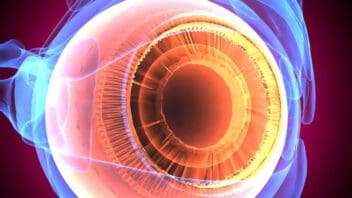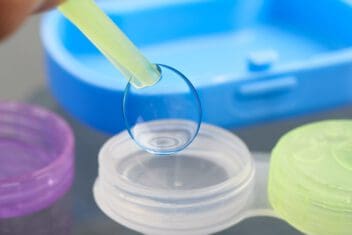Hydrogel Contacts: Everything You Need to Know Before Buying
Home / Understanding Contacts /
Last Updated:
Both silicone and traditional hydrogel contacts are made up of plastic materials. They are hard when dry but designed to absorb water when they get wet, leaving them pliable, flexible, and soft when soaked in contact lens solution before going in your eye. They are made up of gel-like plastic material that contains water.

Hydrogel contact lenses are typically fairly thin and fit onto the front of your eye on top of the cornea to correct a variety of refractive errors.
- Myopia (nearsightedness)
- Hyperopia (farsightedness)
- Astigmatism (corneas that are irregularly shaped)
- Presbyopia (age-related nearsightedness)
The FDA publishes that silicone hydrogel contacts are some of the newest types of soft contact materials.
Table of Contents
One of the most popular types of contact lenses sold in America today are hydrogel, specifically silicone hydrogel, contacts. Hydrogel and silicone hydrogel contacts start out hard when they are dry, and they become soft when they get wet since they absorb water. They are flexible, can be worn for extended periods of time, and let in high levels of oxygen, which helps to prevent dry eye. Silicone hydrogel contacts can be more expensive than traditional soft contact lenses. There are several different types available. Talk to your eye doctor to see if hydrogel contacts are the best option for you.
History of Hydrogel Contacts
The advent of “water-loving” or hydrogel contacts came in the late 1950s. They were some of the first lenses that were made of soft materials instead of rigid and hard plastic.
Hydrogel contacts advanced to silicone hydrogel (SiH) in 1999, and by 2009, they accounted for two-thirds of all contact lenses sold in the United States. In 2014, the number of silicone hydrogel contacts distributed in the U.S. jumped to 70 percent of all contact lenses fitted.
You deserve clear vision. We can help.
With 135+ locations and over 2.5 million procedures performed, our board-certified eye surgeons deliver results you can trust.
Your journey to better vision starts here.
These contacts have quickly become one of the first choices for many Americans.
Hydrogel Contacts Explained

Both silicone and traditional hydrogel contacts are made up of plastic materials. They are hard when dry but designed to absorb water when they get wet, leaving them pliable, flexible, and soft when soaked in contact lens solution before going in your eye. They are made up of gel-like plastic material that contains water.
Hydrogel contact lenses are typically fairly thin and fit onto the front of your eye on top of the cornea to correct a variety of refractive errors.
- Myopia (nearsightedness)
- Hyperopia (farsightedness)
- Astigmatism (corneas that are irregularly shaped)
- Presbyopia (age-related nearsightedness)
The FDA publishes that silicone hydrogel contacts are some of the newest types of soft contact materials.
Benefits of Hydrogel Contacts
Soft hydrogel contact lenses are typically more comfortable to wear than rigid, or hard, lenses, as they are more flexible and move and bend with your eyes.
One of the major issues with contact lens wear is dry eyes. This happens because the lenses block oxygen from reaching the eye as easily. Silicone hydrogel lenses let around five times as much oxygen pass through them and into the eyes, enhancing the flow and helping to reduce dry eyes related to contact lens wear. Hydrogel contacts can be a great option if you are prone to mydriasis (dry eyes).
Hypoxia is a common condition related to contact lens wear as well. It occurs when insufficient oxygen reaches the eye. It can lead to eye infections, especially in contacts that are worn for an extended period of time. Silicon hydrogel contacts may decrease the risk for this.
If you need specialty contact lenses, silicon hydrogel lenses can be a good option since they can be custom fit, are designed to work for irregularly shaped or hard-to-fit eyes, and can be made as bifocals.
Silicon hydrogel contacts may last longer than traditional soft contact lenses due to their durability. This means they may be worn for longer.
Most contacts are not designed for overnight use. While many can be reused, they will still need to be taken out and cleaned every night before replacing them in the morning. Be sure to follow all instructions on contact lens wear to minimize potential issues.
Cost Breakdown and Types

There is a lot of variation in hydrogel and silicon hydrogel contact lenses, which can influence cost. Hydrogel contacts may be designed for daily use and be disposable, which can make them cost more as you will need more of them more often.
Silicon hydrogel contacts can be worn for longer and often can be found in lenses that need to be changed every two weeks or once a month (monthly). These are called extended-wear contacts. They may cost more upfront, but since they are worn for longer, the cost may actually be less in the long run.
You deserve clear vision. We can help.
With 135+ locations and over 2.5 million procedures performed, our board-certified eye surgeons deliver results you can trust.
Your journey to better vision starts here.
Choosing Contact Type
Hydrogel and silicone hydrogel contact lenses may not be suited for everyone, as eyes are individual and fit is personal. They may seem more noticeable and take some time to adjust to.
Silicone hydrogel contacts may collect more bacteria than regular hydrogel or soft contact lenses. Contact lens solution may not clean them as thoroughly as necessary.
Wearing your contacts for longer than recommended can increase the possible risk factors. It is important to closely follow all instructions on wear, cleaning, and disposing of your contacts.
Your eye doctor is the ultimate resource when deciding whether hydrogel or silicon hydrogel contacts will be a good fit for you. They can fit you for these contacts during a contact lens exam, consultation, and fitting.
Hydrogel Contact Lens Brands
Hydrogel lenses are typically thin and fit onto the front part of the eye (the cornea) without causing excessive discomfort.
Compared to regular contacts, hydrogel lenses allow more air to pass through to the cornea, thereby reducing the risk of dry or red eyes. Contact lens wearers with other conditions such as Sjogren’s Syndrome, ones that cause eye dryness because of inadequate secretion of tears, can significantly benefit from hydrogel contacts.
Despite the numerous benefits of hydrogel contacts over the traditional lenses and their popularity, you should never wear these soft contact lenses without a doctor’s prescription. During your eye examination, talk to your ophthalmologist about the most suitable lens for you.
If you receive the go-ahead to use hydrogel contact lenses, some popular lens brands include:
- Proclear
- Acuvue
- Air Optix
Proclear Contacts
Manufactured by CooperVision, Proclear contacts use exclusive PC technology to address issues of eye dryness. The phosphorylcholine-made lenses attract and absorb adequate water, which allows them to remain hydrated throughout the day.
Whether you’re looking for daily disposable contacts or multifocal lenses for presbyopia, Proclear provides an option. Individuals with astigmatism can use the Proclear Toric lenses to overcome the discomfort and irritation other toric contacts are likely to cause.
Proclear is the only brand permitted by the FDA to make claims of providing improved comfort for lens wearers who otherwise experience eye dryness when wearing contact lenses.
Acuvue Contacts
Acuvue lenses are premium-quality contacts manufactured by Johnson & Johnson. Regarded as the world’s best brand of disposable lenses, Acuvue contacts are available in numerous options to correct virtually all vision issues, including astigmatism, myopia, farsightedness, and presbyopia.
Acuvue was the first brand of daily disposable lenses and now utilizes modern technologies such as HYDRACLEAR and HydraLuxe to keep the wearers comfortable.
Air Optix
Widely known for its convenience, Air Optix features a range of monthly disposable lenses that can correct presbyopia, astigmatism, and nearsightedness. In a year, you would need to replace the lenses twelve times.
Air Optix uses Ultra-Smooth Surface technology that makes the lenses comfortable throughout the month as they always have a layer of moisture at the lens surface. Again, Air Optix lenses have a breathability of up to five times the regular contacts.
Other top brands of contact lenses include Dailies, Biofinity, and Freshlook.

Frequently Asked Questions about Contact Lenses
Can you sleep in hydrogel contacts?
Sleeping in regular contacts can result in severe eye conditions such as conjunctivitis and keratitis due to hypoxia. But extended wear contact lenses with high oxygen permeability allow users to sleep with their lenses on. So you can safely sleep in silicone hydrogel extended contacts.
Can you be allergic to silicone hydrogel lenses?
From excessive watering to a burning sensation, allergy to contact lenses manifests with various mild symptoms. Like any other foreign material, silicone hydrogel lenses can elicit allergic reactions in some individuals to cause redness, sensitivity, and itchiness. Tear film deposits or microbial contamination (and not an allergy to silicone alone) may cause the inflammatory response among silicone hydrogel lens wearers.
Are hydrogel contacts easy to put in your eyes?
While hydrogel contacts differ from the usual contacts in flexibility and oxygen permeability, the ease of use is not all that much different. You can wear these lenses just like your previous set of traditional contacts.
You deserve clear vision. We can help.
With 135+ locations and over 2.5 million procedures performed, our board-certified eye surgeons deliver results you can trust.
Your journey to better vision starts here.
References
- When Were Contact Lenses Invented? (August 2017). All About Vision.
- Some Facts About SiHy Lenses. (July 2010). Review of Optometry.
- Silicone Hydrogel Contact Lenses. (September 2016). All About Vision.
- Types of Contact Lenses. (January 2018). U.S. Food and Drug Administration.
- All Brands. Lens.
- Proclear® sphere. Cooper Vision.
- Silicone hydrogel contact lenses: A complete guide. (February 2019). All About Vision.
- Sleeping with contact lenses. Vision Direct.
- Silicone allergies and the eye: fact or fiction? (January 2014) PubMed.
This content is for informational purposes only. It may have been reviewed by a licensed physician, but is not intended to serve as a substitute for professional medical advice. Always consult your healthcare provider with any health concerns. For more, read our Privacy Policy and Editorial Policy.

